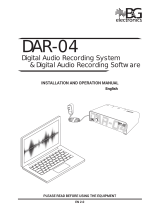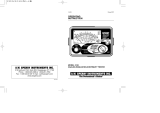
www.megger.comMIT400/2
2
User guide contents
1. Introduction 3
2. G Safety Warnings 4
Symbols used on the instrument 4
WEEE Directive 5
Battery disposal 5
3. General description 6
Unpacking the carton 6
Carton contents (all instruments) 6
4. Preparations for use (all instruments) 7
Batteries 7
Preliminary test lead check 7
5. Instrument overview 8
General functions 8
Display contents 9
Terminal overview 10
6. General operating instructions 11
7. Input Terminals 12
2 terminal test lead connections 12
2 terminal + Guard (MIT2500) 12
3 terminal test lead connection 13
SP5 Switched probe (not MIT400/2) 15
8. AC/DC voltage and frequency
measurements 16
For 2 terminal instruments and MIT2500 16
For 3 terminal instruments
(MIT481/2, MIT485/2 only) 17
Result storage: 18
9. Insulation resistance testing 19
Measurement for 2 terminal instruments
and MIT2500 19
Variable voltage insulation testing
(MIT430/2, MIT485/2, MIT2500) 22
Polarisation Index (PI) and Dielectric
Absorption Ratio (DAR) 22
For 3 terminal instruments
(MIT481/2, MIT485/2 only) 25
ESD testing mode (MIT415/2 and
MIT400ESD) 26
REN mode 27
10. Continuity testing [Ω] 28
Measurement for 2 terminal instruments
and MIT2500 28
Single or bi-directional testing 29
Test lead null 29
Buzzer PASS/FAIL threshold 30
Buzzer ON/OFF 30
PASS / FAIL limit alarm 30
Test current - 20 mA / 200 mA 30
Measurement for 3 terminal instruments 30
Visual fast continuity (silent buzzer) mode 31
REL mode 31
11. Capacitance measurements 32
Capacitance measurement procedure
(2 terminals) 32
Distance measurement by capacitance 32
Capacitance measurement procedure
(3 terminals) 32
12. Saving, recalling and downloading
test results. 33
Saving test results 33
Test results recall 34
PI and DAR recall. 34
Deleting test results 35
Downloading test results 35
Procedure for pairing your MIT to the PC 35
Downloading data to the PC 36
13. SETUP Configuration options 38
14. Specification 39
15. Battery and fuse replacement 41
Battery condition and replacement 41
Procedure to replace batteries 41
Blown fuse indicator 42
Fuse replacement procedure 42
Preventive maintenance 42
16. Repair and Warranty 43
Calibration, Service and Spare Parts 43






















